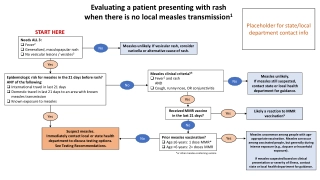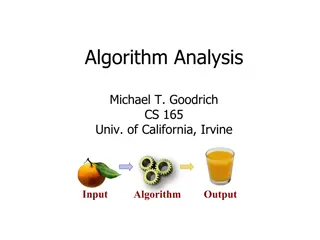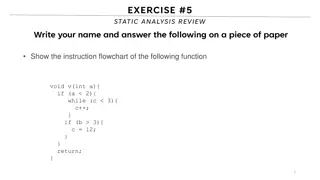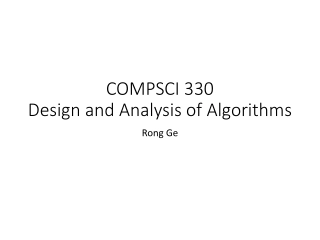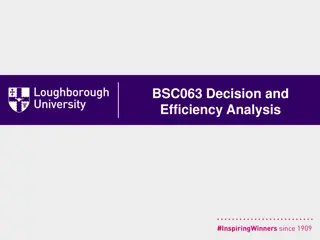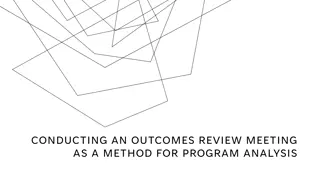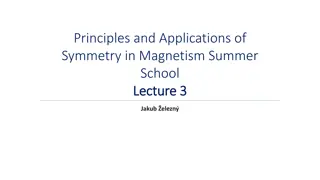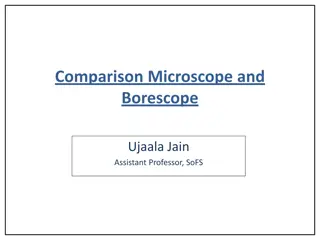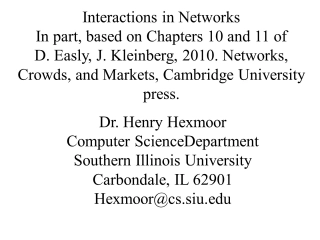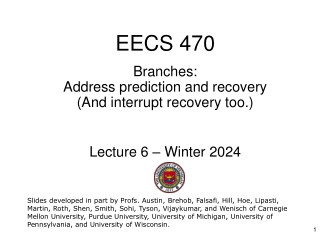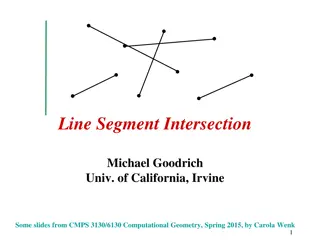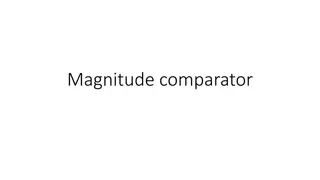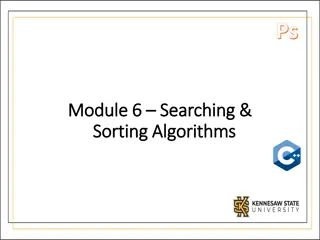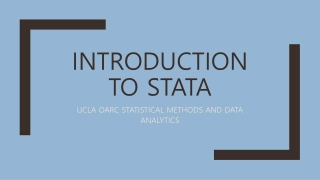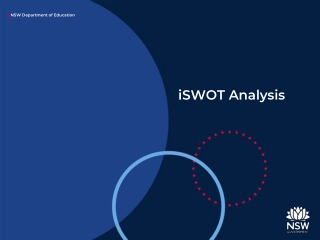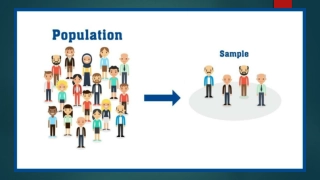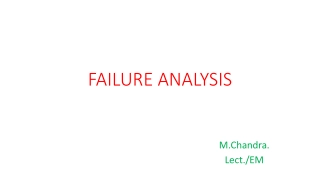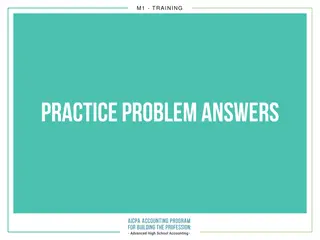Algorithm Analysis
Algorithm analysis involves evaluating the efficiency of algorithms through measures such as time and memory complexity. This analysis helps in comparing different algorithms, understanding how time scales with input size, and predicting performance as input size approaches infinity. Scaling analysis and comparing algorithms based on their runtime complexities are essential aspects of algorithm analysis. Asymptotic complexity analysis focuses on comparing the growth rates of functions to determine algorithm efficiency independently of constant multipliers and lower-order effects.
Algorithm Analysis
PowerPoint presentation about 'Algorithm Analysis'. This presentation describes the topic on Algorithm analysis involves evaluating the efficiency of algorithms through measures such as time and memory complexity. This analysis helps in comparing different algorithms, understanding how time scales with input size, and predicting performance as input size approaches infinity. Scaling analysis and comparing algorithms based on their runtime complexities are essential aspects of algorithm analysis. Asymptotic complexity analysis focuses on comparing the growth rates of functions to determine algorithm efficiency independently of constant multipliers and lower-order effects.. Download this presentation absolutely free.
Presentation Transcript
Chapter 2 Algorithm Analysis Reading: Chapter 2 1
Complexity Analysis Measures efficiency (time and memory) of algorithms and programs Can be used for the following Compare different algorithms See how time varies with size of the input Operation count Count the number of operations that we expect to take the most time Asymptotic analysis See how fast time increases as the input size approaches infinity 2
Operation Count Examples Example 1 for(i=0; i<n; i++) cout << A[i] << endl; Number of outputs = n Example 2 template <class T> bool IsSorted(T *A, int n) { bool sorted = true; for(int i=0; i<n-1; i++) if(A[i] > A[i+1]) sorted = false; return sorted; } Number of comparisons = n - 1 3
Scaling Analysis How much will time increase in example 1, if n is doubled? t(2n)/t(n) = 2n/n = 2 Time will double If time t(n) = 2n2 for some algorithm, then how much will time increase if the input size is doubled? t(2n)/t(n) = 2 (2n)2 / (2n 2) = 4n 2 / n 2 = 4 4
Comparing Algorithms Assume that algorithm 1 takes time t1(n) = 100n+n2 and algorithm 2 takes time t2(n) = 10n2 If an application typically has n < 10, then which algorithms is faster? If an application typically has n > 100, then which algorithms is faster? Assume algorithms with the following times Algorithm 1: insert - n, delete - log n, lookup - 1 Algorithm 2: insert - log n, delete - n, lookup - log n Which algorithm is faster if an application has many inserts but few deletes and lookups? 5
Asymptotic Complexity Analysis Compares growth rate of two functions T = f(n) (estimated run time) Variables: non-negative integers For example, size of input data Values: non-negative real numbers For example, running time of an algorithm Dependent on Eventual (asymptotic) behavior Independent of constant multipliers and lower-order effects Metrics Big O Notation: O() Big Omega Notation: () Big Theta Notation: () 6
Big O Notation f(n) =O(g(n)) If and only if there exist two positive constants c > 0 and n0> 0, such that f(n) < cg(n) for all n >= n0 iff c, n0> 0 | 0 < f(n) < cg(n) n >= n0 cg(n) f(n) f(n) is asymptotically upper bounded by g(n) n0 7
Big Omega Notation f(n) = (g(n)) iff c, n0> 0 | 0 < cg(n) < f(n) n >= n0 f(n) cg(n) f(n) is asymptotically lower bounded by g(n) n0 8
Big Theta Notation f(n) = (g(n)) iff c1, c2, n0> 0 | 0 < c1g(n) < f(n) < c2g(n) n >= n0 c2g(n) f(n) f(n) has the same long-term rate of growth as g(n) c1g(n) n0 9
Example f(n) = 3n2+ 17 (1), (n), (n2) lower bounds O(n2), O(n3), upper bounds (n2) exact bound 10
Analogous to Real Numbers f(n) = O(g(n)) f(n) = (g(n)) f(n) = (g(n)) (a < b) (a > b) (a = b) The above analogy is not quite accurate, but its convenient to think of function complexity in these terms. 11
Transitivity f(n) = O(g(n)) f(n) = (g(n)) f(n) = (g(n)) If f(n) = O(g(n)) and g(n) = O(h(n)) Then f(n) = O(h(n)) If f(n) = (g(n)) and g(n) = (h(n)) Then f(n) = (h(n)) If f(n) = (g(n)) and g(n) = (h(n)) Then f(n) = (h(n)) And many other properties (a < b) (a > b) (a = b) 12
Arithmetic Properties Additive property If e(n) = O(g(n)) and f(n) = O(h(n)) Then e(n) + f(n) = O(g(n) + h(n)) Less formally: O(g(n)+h(n)) = max(O(g(n)), O(h(n)) Multiplicative property If e(n) = O(g(n)) and f(n) = O(h(n)) Then e(n) * f(n) = O(g(n) * h(n)) 13
Some Rules of Thumb If f(n) is a polynomial of degree k Then f(N) = (Nk) logkN = O(N) for any constant k Logarithms grow very slowly compared to even linear growth 14
Exercise f(N) = N logN and g(N) = N1.5 Which one grows faster?? Note that g(N) = N1.5= N*N0.5 Hence, between f(N) and g(N), we only need to compare growth rate of logN and N0.5 Equivalently, we can compare growth rate of log2N with N Now, refer to the result on the previous slide to figure out whether f(N) or g(N) grows faster! 16
Maximum Subsequence Sum Problem Given a sequence of integers A1, A2, , AN Find the maximum subsequence (Ai+ A i+1+ + A k), where 1 < i < N For example for: 2, 11, -4, 13, -5, -2 The answer is 20: (11, -4, 13) Many algorithms of differing complexity can be found Example run times from some computer illustrated below 17
Complexity Analysis Steps Find n = size of input Find atomic activities to count Primitive operations such as +, -, *, /. Assumed to finish within one unit of time Find f(n) = the number of atomic activities done by an input size of n Complexity of an algorithm = complexity of f(n) 19
Running Time Calculations - Loops for (j = 0; j < n; ++j) { // 3 atomics } Number of atomic operations Each iteration has 3 atomic operations, so 3n Cost of the iteration itself One initialization assignment n increment (of j) n comparisons (between j and n) Complexity = (3n) = (n) 20
Loops with Break for (j = 0; j < n; ++j) { // 3 atomics if (condition) break; } Upper bound = O(4n) = O(n) Lower bound = (4) = (1) Complexity = O(n) Why don t we have a ( ) notation here? 21
Sequential Search Given an unsorted vector a, find the location of element X. for (size_t i = 0; i < a.size(); i++) { if (a[i] == X) return true; } return false; Input size: n = a.size() Complexity = O(n) 22
If-then-else Statement if(condition) i = 0; else for ( j = 0; j < n; j++) a[j] = j; Complexity = ?? = O(1) + max ( O(1), O(N)) = O(1) + O(N) = O(N) 23
Consecutive Statements Add the complexity of consecutive statements for (j = 0; j < n; ++j) { // 3 atomics } for (j = 0; j < n; ++j) { // 5 atomics } Complexity = (3n + 5n) = (n) 24
Nested Loop Statements Analyze such statements inside out for (j = 0; j < n; ++j) { // 2 atomics for (k = 0; k < n; ++k) { // 3 atomics } } Complexity = ((2 + 3n)n) = (n2) 25
Recursion long factorial( int n ) { if( n <= 1 ) return 1; else return n * factorial( n - 1 ); } This is really a simple loop disguised as recursion Complexity = O(n) Fibonacci Series: Terrible way to Implement recursion Complexity = ((3/2)N ) That s Exponential !! long fib( int n ) { if ( n <= 1) return 1; else return fib( n 1 ) + fib( n 2 ); } We need to determine how many times a recursive function is called 26
Logarithms in Running Time General rule: If constant time is required to merely reduce the problem by a constant amount, the algorithm is O(N). An algorithm is O(logN) if it takes constant O(1) time to cut the problem size by a fraction (usually N). Binary search Euclid s Algorithm Exponentiation 27
Binary Search Given a sorted vector a, find the location of element X int binary_search(const vector<int> & a, int X) { unsigned int low = 0, high = a.size()-1; while (low <= high) { int mid = (low + high) / 2; if (a[mid] < X) low = mid + 1; else if( a[mid] > X ) high = mid - 1; else return mid; } return NOT_FOUND; } Input size: n = a.size() Complexity = O( k iterations x (1 comparison+1 assignment) per loop) = O(log(n)) 28
Euclids Algorithm Find the greatest common divisor (gcd) between m and n Given M > N For example M = 50, N = 15 Remainders 5, 0 So gcd(50, 15) = 5 Complexity = O(logN) Exercise: Why is it O(logN) ? If M > N, then (M mod N) < M/2 29
Exponentiation Calculate xn Example: x11= x5* x5* x x5= x2* x2* x x2= x * x Complexity = O( logN ) Why didn t we implement the recursion as follows? pow(x,n/2)*pow(x,n/2)*x 30


